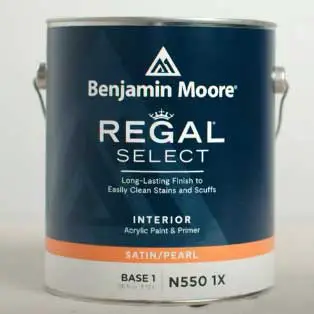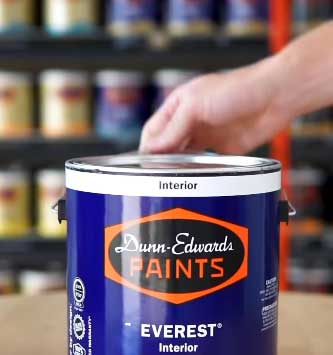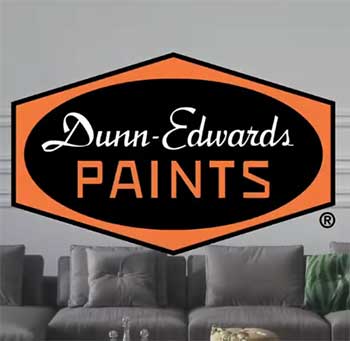I’ve painted my fair share of walls, from cozy living rooms to sun-baked exteriors, and choosing the right paint brand can make or break a project.
Today, I’m comparing Dunn-Edwards and Benjamin Moore, two heavyweights in the paint world, to help you decide which one suits your needs. Whether you’re a homeowner tackling a DIY refresh or a contractor aiming for a flawless finish, this article will break down their key features, pros, cons, and performance.
By the end, you’ll have a clear picture of which brand deserves a spot on your paint roller.
A Brief Comparison Table
| Feature | Dunn-Edwards | Benjamin Moore |
| Price per Gallon | $50–$70 (Suprema, Aristoshield) | $47–$90 (Ben, Aura) |
| Color Selection | ~1,400 colors | ~1,700 colors |
| VOC Levels | Zero-VOC options, stricter formulas | Zero-VOC options, slightly less strict |
| Durability | Excellent, especially for exteriors | Superior, especially for interiors |
| Coverage | Good, fewer coats on porous surfaces | Exceptional, often one-coat coverage |
| Availability | Primarily Southwest, limited nationwide | Nationwide, widely accessible |
| Popular Lines | Suprema, Aristoshield, Spartawall | Aura, Regal Select, Ben, Advance |
| Warranty | Limited, varies by retailer | Comprehensive, lifetime in some cases |
| Best For | Hot, dry climates, budget-conscious | High-end interiors, color precision |
Why Paint Brands Matter?

When I first started painting, I thought a can of paint was just a can of paint. Boy, was I wrong.
The brand you choose affects everything—how smoothly it glides on, how long it lasts, and whether you’re cursing the roller after three coats.
Dunn-Edwards and Benjamin Moore are two brands I’ve come to respect for their quality, but they cater to different needs.
Dunn-Edwards, a Southwest staple since 1925, is known for its rugged durability in harsh climates.
Benjamin Moore, founded in 1883, is a nationwide favorite for its rich colors and premium performance. Let’s explore what makes each stand out.
Dunn-Edwards: The Southwest Champion
I first encountered Dunn-Edwards when I moved to Arizona, where the sun is relentless and paint needs to hold up. This brand has been a go-to for contractors in California, Arizona, and Nevada, and it’s easy to see why.
Their paints are formulated to withstand UV rays, heat, and dry conditions, making them a top pick for exterior projects in desert climates.
Key Features of Dunn-Edwards

- Suprema: This ultra-low VOC acrylic latex paint is a favorite for interiors. It’s got exceptional hide, meaning it covers imperfections well, and comes in five finishes, from flat to semi-gloss. I’ve used Suprema on living room walls, and its smooth application made the job a breeze.
- Aristoshield: This line offers an oil-like finish for doors, trim, and even metal surfaces. It’s a direct-to-metal coating, which saved me time on a recent fence project—no primer needed.
- Spartawall: Perfect for indoor commercial or residential spaces, Spartawall has low odor and applies easily. I painted a home office with it, and the lack of fumes was a game-changer for working in tight spaces.
- Evershield: For exteriors, this is Dunn-Edwards’ heavy hitter. It resists fading, chalking, and cracking, and I’ve seen it keep homes looking fresh for over a decade in Phoenix’s brutal sun.
- ChromaStay Technology: This ensures colors stay vibrant, even under harsh sunlight. I used their Exquisite line with this tech on a stucco exterior, and the color still pops years later.
Pros of Dunn-Edwards
- Climate-Specific Formulas: Dunn-Edwards shines in hot, dry environments. Their paints are engineered for the Southwest’s intense sun and low humidity, making them ideal for exterior projects in places like Arizona or Nevada.
- Affordable Quality: At $50–$70 per gallon for premium lines, Dunn-Edwards is often 10–20% cheaper than Benjamin Moore’s top-tier paints. For large projects, this adds up.
- High Volume Solids: Lines like Exquisite have more paint solids per gallon, which means better coverage and fewer coats. I’ve painted porous concrete walls with Suprema and needed only two coats for a flawless finish.
- Zero-VOC Options: Dunn-Edwards takes low-VOC seriously, offering stricter formulas than many competitors. This is a big win for families or those sensitive to fumes.
- Contractor-Friendly: Local contractors swear by Dunn-Edwards for its reliable supply chain and knowledgeable staff. I’ve walked into their stores and gotten spot-on advice for matching colors or tackling tricky surfaces.
Cons of Dunn-Edwards
- Limited Availability: Unless you’re in the Southwest, finding Dunn-Edwards can be a hassle. I once tried to order their paint for a project in the Midwest and ended up paying hefty shipping fees.
- Touch-Up Challenges: Some painters, including me, have noticed that Suprema can be tricky to touch up. The paint blends well initially but can show patches if you go back later.
- Fewer Color Options: With around 1,400 colors, Dunn-Edwards has a solid palette, but it’s not as extensive as Benjamin Moore’s. I’ve occasionally struggled to find the exact shade I wanted.
- Limited Warranty: Their warranties vary by retailer and aren’t as robust as Benjamin Moore’s. I’ve had to rely on the paint’s performance rather than a safety net.
Benjamin Moore: The Nationwide Standard
Benjamin Moore is the brand I reach for when I want a luxurious finish or a specific color that screams sophistication. Available across the U.S., it’s a favorite among professional painters for its consistency and premium feel.
I’ve used their paints in high-end homes, and the results always impress.
Key Features of Benjamin Moore

- Aura: This is their top-tier line, known for incredible durability and color depth. I painted a dining room with Aura, and it covered a dark red wall in just two coats—no primer needed.
- Regal Select: A versatile option for interiors, Regal Select offers great coverage and a smooth finish. It’s my go-to for bedrooms and living spaces where I want a polished look.
- Ben: The budget-friendly line, Ben is perfect for DIYers or rental properties. I used it for a quick apartment refresh, and it held up surprisingly well for the price.
- Advance: Ideal for cabinets and trim, this line dries to a hard, furniture-like finish. I painted kitchen cabinets with Advance, and they’ve withstood years of wear.
- Gennex Color Technology: Benjamin Moore’s proprietary colorant ensures vibrant, fade-resistant colors. I’ve seen their exterior paints hold up in humid East Coast climates without losing their pop.
Pros of Benjamin Moore
- Superior Coverage: Benjamin Moore’s high volume solids mean you often need fewer coats. I’ve saved hours on projects because Aura or Regal Select covers so well.
- Nationwide Availability: Whether I’m in New York or Texas, I can find Benjamin Moore at local retailers. This makes it a no-brainer for cross-country projects.
- Rich Color Selection: With over 1,700 colors, Benjamin Moore offers unmatched variety. I’ve used their Historical Color palette for a colonial home, and the desaturated tones were perfect.
- Comprehensive Warranties: Their lifetime warranties on premium lines like Aura give me peace of mind. I’ve never had to use one, but it’s nice to know it’s there.
- Professional Praise: Painters I’ve worked with rave about Benjamin Moore’s consistency. Its thicker consistency makes it forgiving for brushing, rolling, or spraying.
Cons of Benjamin Moore
- Higher Price Point: Aura can hit $90 per gallon, which stings for big jobs. I’ve had to budget carefully when using their premium lines.
- Thicker Consistency: While great for coverage, the paint can be harder to work with, especially for beginners. I’ve seen DIYers struggle to clean it from brushes.
- Limited Performance in Harsh Climates: In desert conditions, Benjamin Moore’s exterior paints don’t always match Dunn-Edwards’ UV resistance. I’ve noticed slight fading on a Southwest project after a few years.
- Color Matching Variability: While rare, I’ve had occasional issues with color consistency across batches, especially with custom mixes.
How Dunn-Edwards And Benjamin Moore Stack Up?
Let’s break down the key areas where Dunn-Edwards and Benjamin Moore differ. I’ve painted with both brands extensively, so I’ll share what I’ve learned from real-world experience.
- Durability

Both brands are built to last, but their strengths lie in different areas.
Dunn-Edwards excels in exterior durability, especially in hot, dry climates.
Their Evershield and Spartashield lines resist fading, chalking, and cracking, even under intense UV exposure.
I painted a stucco home in Nevada with Evershield, and it still looks pristine after 12 years.
Benjamin Moore, on the other hand, is a beast for interior durability. Their Aura and Regal Select lines resist stains, scrubbing, and fading, making them ideal for high-traffic areas like hallways or kitchens. I used Regal Select in a family home with kids, and the walls still look clean after years of abuse. For exteriors, Benjamin Moore’s Aura Exterior holds up well in humid or cold climates but can’t quite match Dunn-Edwards in desert conditions.
Winner: Dunn-Edwards for exteriors, Benjamin Moore for interiors.
- Coverage
Coverage is where Benjamin Moore often steals the show. Their high volume solids, especially in Aura, mean you can sometimes get away with one coat. I painted over a navy accent wall with Aura, and it was fully covered in two coats—no primer.
Dunn-Edwards’ Suprema and Exquisite are no slouches, offering good coverage on porous surfaces like stucco or concrete, but they sometimes require an extra coat on smoother surfaces.
I’ve found Dunn-Edwards works best when you’re prepping rough textures.
Winner: Benjamin Moore.
- Ease of Application
Both brands apply smoothly, but Dunn-Edwards has a slight edge for beginners. Their paints, like Spartawall, flow easily and dry quickly, reducing drips and streaks. I’ve had DIY clients rave about how forgiving Suprema is.
Benjamin Moore’s thicker paints, while great for pros, can feel heavy for novices. I’ve seen new painters struggle with Aura’s viscosity, especially when rolling. However, once you get the hang of it, Benjamin Moore’s consistency is a dream for precise brushwork.
Winner: Dunn-Edwards for beginners, Benjamin Moore for pros.
- Color Selection
Benjamin Moore’s 1,700+ colors give it a clear advantage. Their Gennex Color Technology ensures vibrant, long-lasting hues, and I’ve loved browsing their Historical and Williamsburg palettes for unique shades.
Dunn-Edwards’ 1,400 colors are still impressive, and their ChromaStay Technology keeps colors true in harsh sunlight. However, I’ve occasionally found Dunn-Edwards’ palette limiting for bold or niche tones.
Winner: Benjamin Moore.
- VOCs and Environmental Impact
Both brands offer zero-VOC options, but Dunn-Edwards takes it a step further with stricter formulas. Their paints, produced in a LEED-certified facility, are a great choice for eco-conscious projects.
I’ve used their zero-VOC lines in nurseries without worrying about fumes. Benjamin Moore’s zero-VOC paints are also safe, but I’ve noticed they perform slightly less well in high-humidity environments. If you’re painting in a damp climate, you might need to double-check ventilation.
Winner: Dunn-Edwards.
- Availability
This is where Benjamin Moore dominates. Available nationwide at independent retailers and ACE Hardware, I’ve never struggled to find their paint. Dunn-Edwards, while a powerhouse in the Southwest, is tough to source elsewhere.
I once had to delay a project because I couldn’t get Dunn-Edwards shipped in time. If you’re outside California or Arizona, Benjamin Moore is the easier choice.
Winner: Benjamin Moore.
- Price
Dunn-Edwards is generally more budget-friendly, with premium lines like Suprema at $60–$70 per gallon. Benjamin Moore’s Aura can hit $90, though their Ben line starts at $47.
For large exterior jobs, I’ve leaned toward Dunn-Edwards to keep costs down without sacrificing quality. However, Benjamin Moore’s superior coverage can mean fewer gallons overall, which sometimes evens out the cost.
Winner: Dunn-Edwards for budget, Benjamin Moore for value.
Real-World Applications: My Experiences

To give you a sense of how these paints perform, let me share a couple of projects.
For an exterior repaint in Tucson, I used Dunn-Edwards Evershield on a stucco home.
The paint went on smoothly, covered well, and has held up against five years of scorching summers without fading.
The client was thrilled, and I appreciated the cost savings compared to Benjamin Moore’s Aura Exterior.
For an interior job in a Boston brownstone, I chose Benjamin Moore Regal Select for the living room and Aura for a statement wall. The coverage was phenomenal, and the colors (a soft gray and deep teal) looked rich and elegant.
The client loved the washability—spills from a dinner party wiped right off. However, the Aura was pricier, and I had to be meticulous with cleanup due to its thicker texture.
How They Compare To Sherwin-Williams?
You might be wondering how these brands stack up against Sherwin-Williams, another industry giant. In my experience, Sherwin-Williams falls between Dunn-Edwards and Benjamin Moore.
Their SuperPaint and Emerald lines are comparable to Benjamin Moore’s Regal Select for quality but are closer to Dunn-Edwards in price. Sherwin-Williams has nationwide availability like Benjamin Moore but doesn’t match Dunn-Edwards’ performance in desert climates.
If you’re debating all three, Dunn-Edwards is best for Southwest exteriors, Benjamin Moore for premium interiors, and Sherwin-Williams for a balanced middle ground.
Choosing The Right Paint For You
Your choice depends on your project and priorities. If you’re in a hot, sunny climate and need exterior paint that won’t quit, Dunn-Edwards is your best bet. Its affordability and climate-specific formulas make it a contractor’s dream.
For interior projects or if you’re after a specific color and top-tier durability, Benjamin Moore’s premium lines are worth the splurge. I’ve learned that prep work—sanding, priming, cleaning—is just as crucial as the paint brand, so don’t skimp there, no matter which you choose.
Frequently Asked Questions (FAQ)
Yes, Dunn-Edwards is high quality, especially for exteriors in hot climates. Its premium lines like Suprema and Evershield offer excellent durability and coverage.
Dunn-Edwards matches Sherwin-Williams in quality, particularly for Southwest exteriors, but Sherwin-Williams has broader availability and a wider color range.
Painters love Benjamin Moore for its superior coverage, rich colors, and ease of application. Lines like Aura and Regal Select are reliable and versatile.
Evershield is Dunn-Edwards’ top exterior paint, known for its UV resistance, durability, and smooth finish in harsh climates.
Wrapping Up
You’re now armed with everything you need to choose between Dunn-Edwards and Benjamin Moore. If you’re painting in the Southwest or on a budget, Dunn-Edwards’ climate-specific formulas and affordability make it a solid pick.
If you want premium colors and unmatched interior performance, Benjamin Moore’s your go-to. Whichever you choose, you’re investing in quality that’ll make your space shine.
So grab a roller, pick your paint, and transform your home with confidence!
